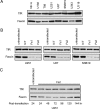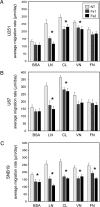The role of fascin in the migration and invasiveness of malignant glioma cells
- PMID: 18283337
- PMCID: PMC2244690
- DOI: 10.1593/neo.07909
The role of fascin in the migration and invasiveness of malignant glioma cells
Abstract
Malignant glioma is the most common primary brain tumor, and its ability to invade the surrounding brain parenchyma is a leading cause of tumor recurrence and treatment failure. Whereas the molecular mechanisms of glioma invasion are incompletely understood, there is growing evidence that cytoskeletal-matrix interactions contribute to this process. Fascin, an actin-bundling protein, induces parallel actin bundles in cell protrusions and increases cell motility in multiple human malignancies. The role of fascin in glioma invasion remains unclear. We demonstrate that fascin is expressed in a panel of human malignant glioma cell lines, and downregulation of fascin expression in glioma cell lines by small interfering RNA (siRNA) is associated with decreased cellular attachment to extracellular matrix (ECM) and reduced migration. Using immunofluorescence analysis, we show that fascin depletion results in a reduced number of filopodia as well as altered glioma cell shape. In vitro invasiveness of U251, U87, and SNB19 glioma cells was inhibited by fascin siRNA treatment by 52.2%, 40.3%, and 23.8% respectively. Finally, we show a decreased invasiveness of U251-GFP cells by fascin knockdown in an ex vivo rat brain slice model system. This is the first study to demonstrate a role for fascin in glioma cell morphology, motility, and invasiveness.
Figures







Similar articles
-
Galectin-3 increases gastric cancer cell motility by up-regulating fascin-1 expression.Gastroenterology. 2010 Mar;138(3):1035-45.e1-2. doi: 10.1053/j.gastro.2009.09.061. Epub 2009 Oct 8. Gastroenterology. 2010. PMID: 19818782
-
Fascin-1 expression correlates with repression of E-cadherin expression in hepatocellular carcinoma cells and augments their invasiveness in combination with matrix metalloproteinases.Cancer Sci. 2011 Jun;102(6):1228-35. doi: 10.1111/j.1349-7006.2011.01910.x. Epub 2011 Mar 14. Cancer Sci. 2011. PMID: 21323792 Free PMC article.
-
Semaphorin 5A and plexin-B3 regulate human glioma cell motility and morphology through Rac1 and the actin cytoskeleton.Oncogene. 2012 Feb 2;31(5):595-610. doi: 10.1038/onc.2011.256. Epub 2011 Jun 27. Oncogene. 2012. PMID: 21706053
-
Fascin: a key regulator of cytoskeletal dynamics.Int J Biochem Cell Biol. 2010 Oct;42(10):1614-7. doi: 10.1016/j.biocel.2010.06.019. Epub 2010 Jun 30. Int J Biochem Cell Biol. 2010. PMID: 20601080 Review.
-
Roles of fascin in cell adhesion and motility.Curr Opin Cell Biol. 2004 Oct;16(5):590-6. doi: 10.1016/j.ceb.2004.07.009. Curr Opin Cell Biol. 2004. PMID: 15363811 Review.
Cited by
-
Fascin overexpression promotes neoplastic progression in oral squamous cell carcinoma.BMC Cancer. 2012 Jan 20;12:32. doi: 10.1186/1471-2407-12-32. BMC Cancer. 2012. PMID: 22264292 Free PMC article.
-
Tunneling nanotubes provide a unique conduit for intercellular transfer of cellular contents in human malignant pleural mesothelioma.PLoS One. 2012;7(3):e33093. doi: 10.1371/journal.pone.0033093. Epub 2012 Mar 9. PLoS One. 2012. PMID: 22427958 Free PMC article.
-
The Guanine Nucleotide Exchange Factor SWAP-70 Modulates the Migration and Invasiveness of Human Malignant Glioma Cells.Transl Oncol. 2009 Dec;2(4):300-9. doi: 10.1593/tlo.09172. Transl Oncol. 2009. PMID: 19956392 Free PMC article.
-
AJAP1 is dysregulated at an early stage of gliomagenesis and suppresses invasion through cytoskeleton reorganization.CNS Neurosci Ther. 2014 May;20(5):429-37. doi: 10.1111/cns.12232. Epub 2014 Feb 1. CNS Neurosci Ther. 2014. PMID: 24483339 Free PMC article.
-
Tumor self-seeding by circulating cancer cells.Cell. 2009 Dec 24;139(7):1315-26. doi: 10.1016/j.cell.2009.11.025. Cell. 2009. PMID: 20064377 Free PMC article.
References
-
- Burger PC, Vogel FS, Green SB, Strike TA. Glioblastoma multiforme and anaplastic astrocytoma. Pathologic criteria and prognostic implications. Cancer. 1985;56(5):1106–1111. - PubMed
-
- Stupp R, Hegi ME, Gilbert MR, Chakravarti A. Chemoradiotherapy in malignant glioma: standard of care and future directions. J Clin Oncol. 2007;25(26):4127–4136. - PubMed
-
- Soffietti R, Leoncini B, Ruda R. New developments in the treatment of malignant gliomas. Expert Rev Neurother. 2007;7(10):1313–1326. - PubMed
-
- Goffman TE, Dachowski LJ, Bobo H, Oldfield EH, Steinberg SM, Cook J, Mitchell JB, Katz D, Smith R, Glatstein E. Long-term followup on National Cancer Institute Phase I/II study of glioblastoma multiforme treated with iododeoxyuridine and hyperfractionated irradiation. J Clin Oncol. 1992;10(2):264–268. - PubMed
-
- Senger D, Cairncross JG, Forsyth PA. Long-term survivors of glioblastoma: statistical aberration or important unrecognized molecular subtype? Cancer J. 2003;9(3):214–221. - PubMed
Publication types
MeSH terms
Substances
LinkOut - more resources
Full Text Sources
Miscellaneous
